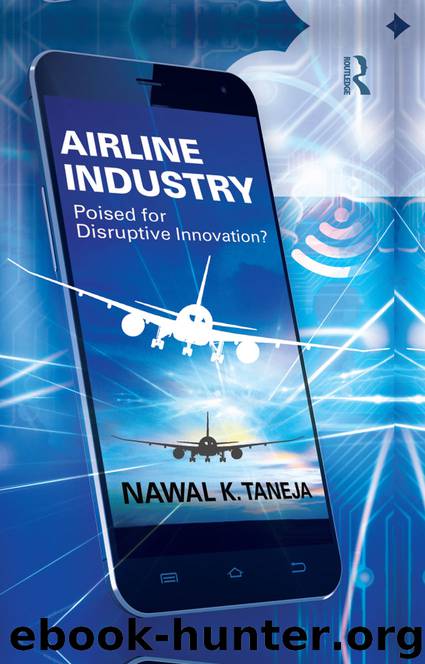Airline Industry by Taneja Nawal K.;

Author:Taneja, Nawal K.;
Language: eng
Format: epub
ISBN: 4568572
Publisher: Routledge
Takeaways
Airports have been changing their business models in four areas – general framework, low-cost terminals, customer experience, and airports as destinations.
Airports are also adapting, although at a slower pace than airlines, to the three major forces of change (and their convergence) discussed in Chapter 3 – competition, consumer behavior, and technology.
In some areas the goals of airlines and airports are the same – improve the customer experience and enhance ancillary revenues, for example. However, in some areas, the goals are diametrically opposed. Airlines prefer to move passengers through the airport as quickly as possible. Airports prefer for passengers to spend as much time as possible to increase the retail-related revenue stream.
Despite the desire of both airline and airport to enhance the customer experience, the question of which entity “owns” the customer, at the airport, remains open. Airlines and airports are still at odds, especially when it comes to sharing data and processes. This lack of communication often results in missed opportunities between the airport and the airline, creating an opportunity for disruption.
By re-designing their facilities and services, airports can not only improve customer experience but also their ancillary revenues.
The desire by the LCCs to connect to their own flights as well as with full-service airlines is bringing about dramatic changes in airports and other organizations, such as within alliances. The emergence of major hybrid airlines, requiring cost-effective connectivity, will bring about major transformations within airports.
Airports, having used vast quantities of data for operational control and effective use of assets, are beginning to use the data, coupled with analytics (particularly predictive) to engage with customers proactively and improve passenger experience and generate more revenue.
Opportunities for disruptive innovation exist in the areas of airport facilities (parking and car rental, for example), and baggage collection and delivery (through the involvement of third parties such as fast-delivery service providers).
Download
This site does not store any files on its server. We only index and link to content provided by other sites. Please contact the content providers to delete copyright contents if any and email us, we'll remove relevant links or contents immediately.
| Airport | Commercial |
| Helicopters | History |
| Pictorial | Piloting & Flight Instruction |
| Repair & Maintenance |
Small Unmanned Fixed-wing Aircraft Design by Andrew J. Keane Andras Sobester James P. Scanlan & András Sóbester & James P. Scanlan(32577)
Navigation and Map Reading by K Andrew(4892)
Endurance: Shackleton's Incredible Voyage by Alfred Lansing(4509)
And the Band Played On by Randy Shilts(2017)
Wild Ride by Adam Lashinsky(1872)
The Box by Marc Levinson(1865)
Top 10 Prague (EYEWITNESS TOP 10 TRAVEL GUIDES) by DK(1852)
The Race for Hitler's X-Planes: Britain's 1945 Mission to Capture Secret Luftwaffe Technology by John Christopher(1742)
The One Percenter Encyclopedia by Bill Hayes(1720)
Trans-Siberian Railway by Lonely Planet(1632)
Girls Auto Clinic Glove Box Guide by Patrice Banks(1623)
Looking for a Ship by John McPhee(1576)
Batavia's Graveyard by Mike Dash(1554)
TWA 800 by Jack Cashill(1532)
Fighting Hitler's Jets: The Extraordinary Story of the American Airmen Who Beat the Luftwaffe and Defeated Nazi Germany by Robert F. Dorr(1519)
Troubleshooting and Repair of Diesel Engines by Paul Dempsey(1500)
Good with Words by Patrick Barry(1497)
Bligh by Rob Mundle(1492)
Ticket to Ride by Tom Chesshyre(1485)
